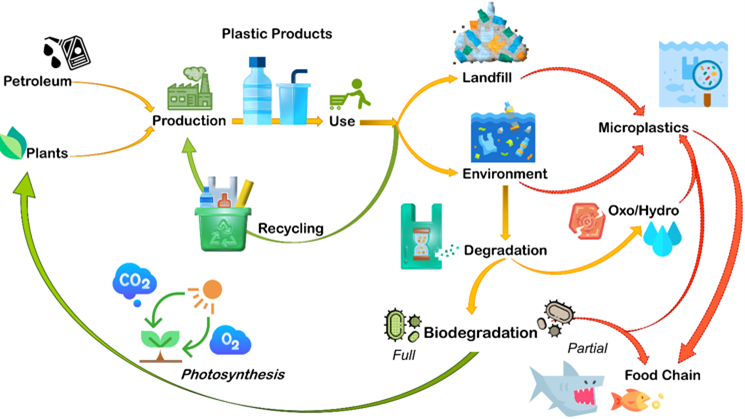Biodegradable plastics have an important role to play in the greening of our society and in the transition to a circular economy, say Dr. Layla Filiciotto and Prof. Gadi Rothenberg from the Van ‘t Hoff Institute for Molecular Sciences, but there’s still a long way to go.
Abundance of plastics
Plastics are literally everywhere: In our clothes, bottles, cars, and even in our walls as insulators. The amount of plastics we use is huge, and growing: Worldwide production of plastics in 2019 was a staggering 370 million metric tons. That’s 50 kg of plastic for every single person on this planet in a single year!
There are good reasons for this popularity: Plastics have several advantages over metal and paper: lower production energy cost, low maintenance, corrosion resistance, lightness and durability are all in their favour.
Effects on health and invironment
Polymer foam insulators, for example, have improved the energy efficiency of our homes 200-fold, and plastic packaging keeps our food products fresh without using preservatives. Yet it looks like mankind’s long-term romance with plastics is starting to decline, because of their effects on human health and on the environment. To keep this multi-billion-dollar market rolling, the chemical industry is looking to develop plastics with new properties and/or starting from new raw materials. The two magic terms in this context are “bio-based” and “biodegradable”. Such new plastics are set to substitute the current persistent ones in the packaging, single-use, agricultural and fishing sectors.
Issues of biodegradability
Yet moving from traditional plastics to eco-friendly ones is a tricky challenge. The very definitions of “bio-based” and “biodegradable” are unclear. Adjectives such as “green”, “circular” or indeed “eco-friendly” are even vaguer. Producers, consumers and policy-makers are faced with a plethora of choices and approaches, where relevant information is hard to come by. In a recent critical review in ChemSusChem, Dr. Layla Filiciotto and Prof. Gadi Rothenberg of the Van ‘t Hoff Institute for Molecular Sciences put things in perspective. By examining the socio-economic and environmental impacts of biodegradable and bio-based plastics, as well as providing a hands-on approaches on assessing biodegradability including certifications and policies, their work can help people make better-informed decisions about plastics in the future.
Researching biobased resin composites
This study is part of the large multi-partner biobased resin composites (BRECSIT) project, funded by the Netherlands Innovation Authority (RVO) and managed by the Institute for Sustainable Process Technology (ISPT). The six industrial partners in the project are looking at the application of biobased composite resins in a host of applications, from household furniture all the way to 100-metre poles for electricity-producing windmills.
Biodegradable plastics can overturn the problem of littering, the formation of microplastics and, if made from biomass (such as plants or organic waste), can even reduce carbon emissions (see figure). Especially in applications where plastics are used for less than 6 months and can easily leak to the environment, shouldn’t we use biodegradable plastics as the obvious choice?

It seems like a no-brainer, but the situation is complex. Filiciotto and Rothenberg studied the environmental and socioeconomic impact of biodegradable plastics by following their CO2 footprint, price and quantities produced, and hazard and safety factors. They also examined the different policies worldwide and how these policy differences affect the development of biodegradable plastics. Combining these results with a chemical perspective on how the standard biodegradability tests are carried out and what are their limitations gives a complete picture of the world plastic flows that shows just how far we still have to go (see the material flow analysis for 2019, where the thickness of each line reflects the size of each plastic stream).
Finding the right plastics
More and more people are aware of the problems created by plastic waste and microplastic pollution. We are also waking up to the hidden health costs of our produce-use-waste economy in general. And this is important, because the chemical industry can produce more biodegradable plastics if the customers so choose. Knowing the difference between petro-based, bio-based, biodegradable and compostable plastics can help people make the right decisions. Some plastic products (Lego bricks, for example) should stay forever – it’s all about finding the right plastic for the right application.
This article was originally published at the website of the University of Amsterdam. Click here to read the article in Dutch.
